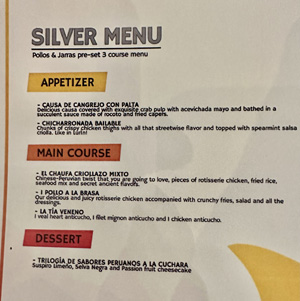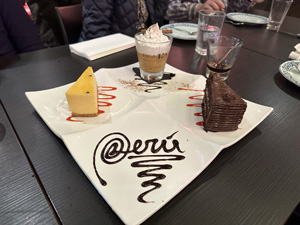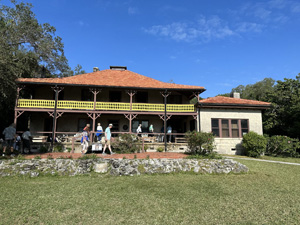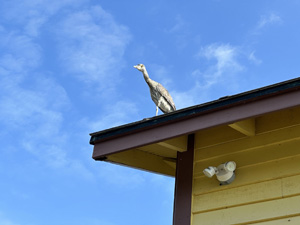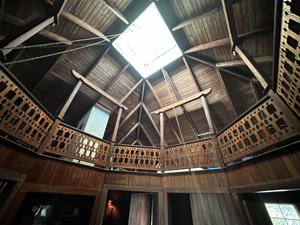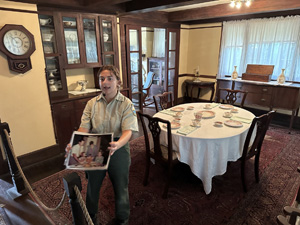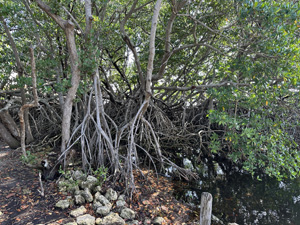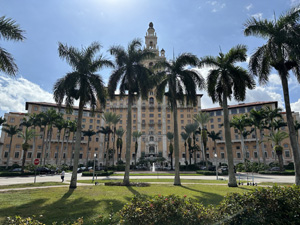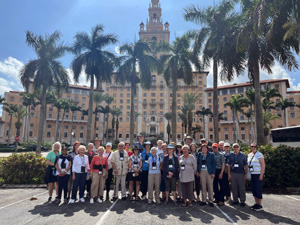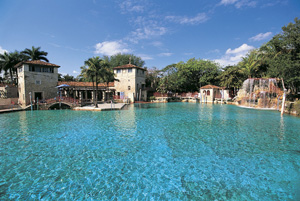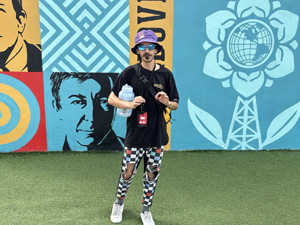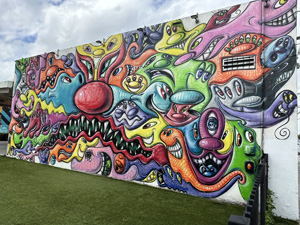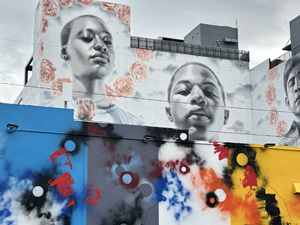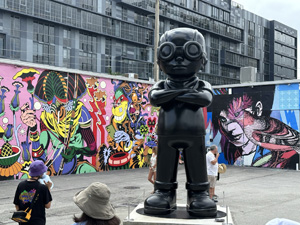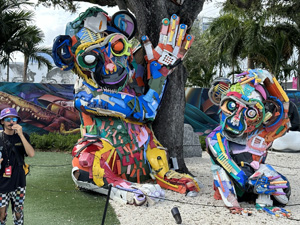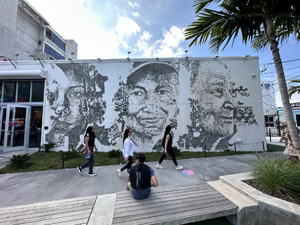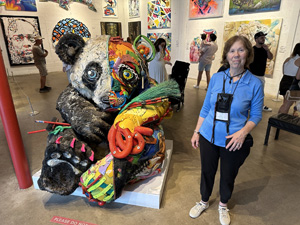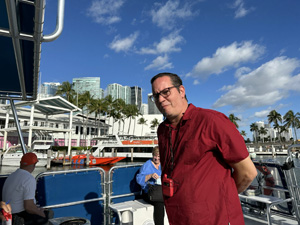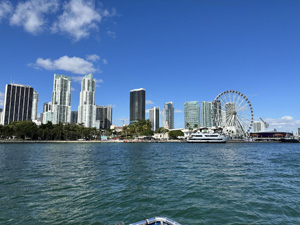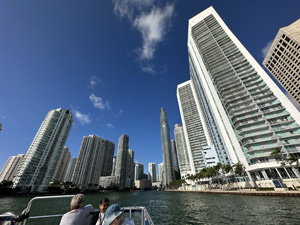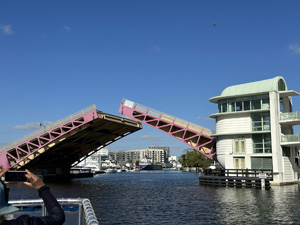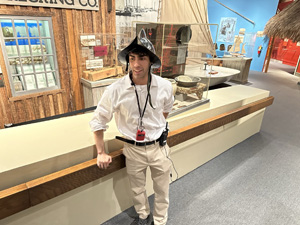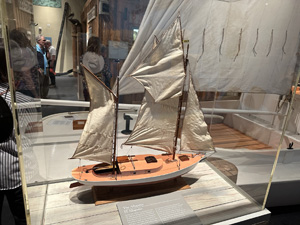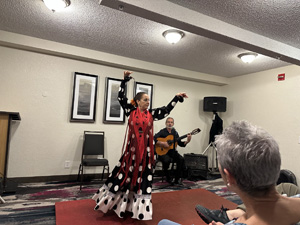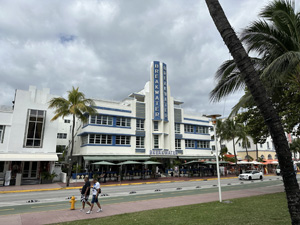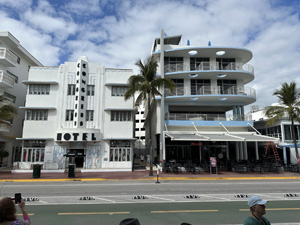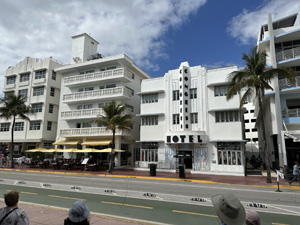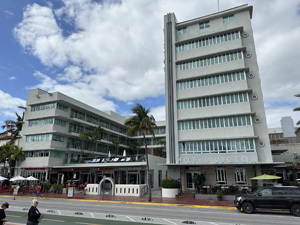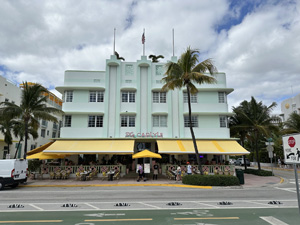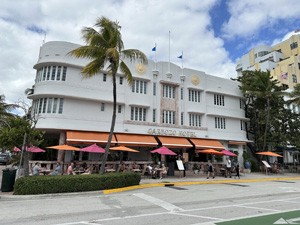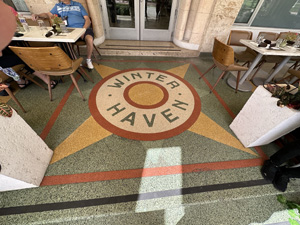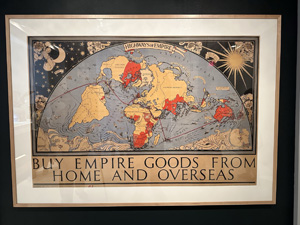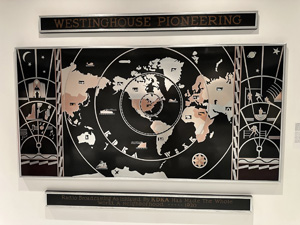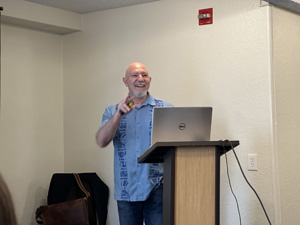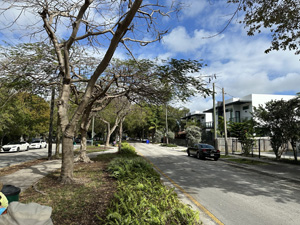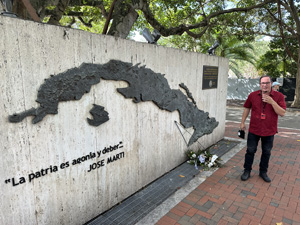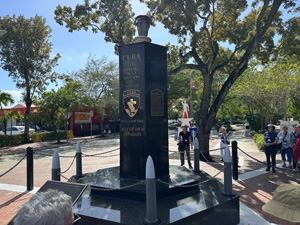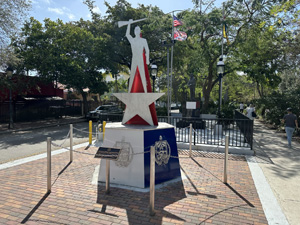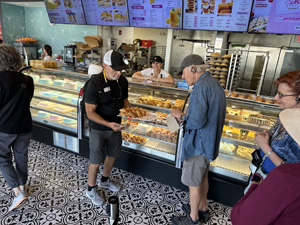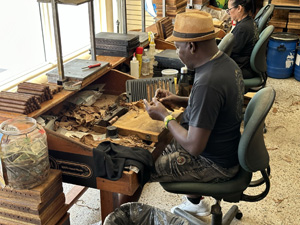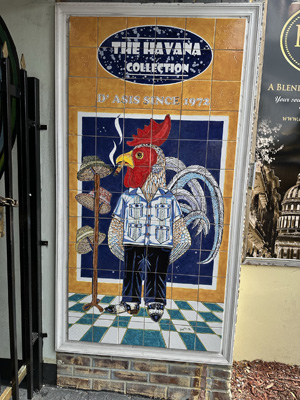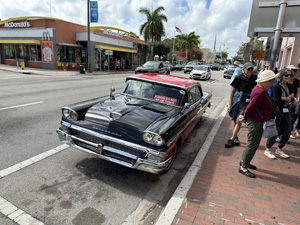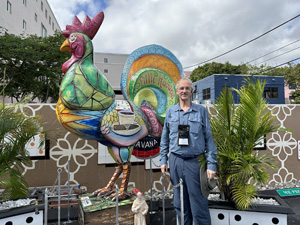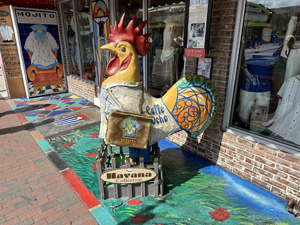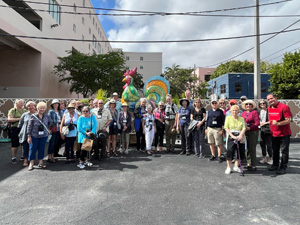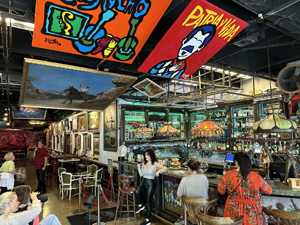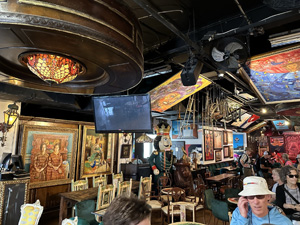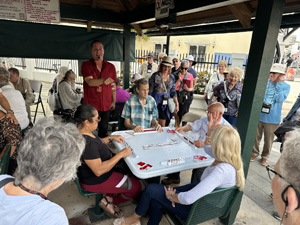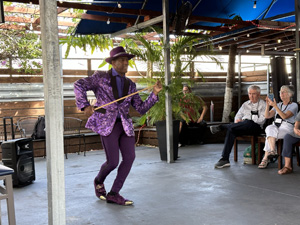Hal and Nancy’s Road Scholar Trip to Miami, February 2023
This is Hal’s report of Hal and Nancy’s “Signature City Miami” excursion with Road Scholar. It was my (Hal’s) 22nd Road Scholar learning adventure, Nancy’s 20th.
Sunday, February 5 — To Miami
We flew American Airlines direct from SFO to MIA. We were delayed 30 minutes in a holding pattern because of a brief thunderstorm that hit near our landing time. That plus really slow baggage service made us late for our Road Scholar intro meeting at the Courtyard by Marriott Downtown hotel. There are about 30 folks for the tour. Our tour leader is Jose Diaz, a Miami resident who emigrated from Cuba as a young child.
Dinner was a few blocks away at Pollos & Jarros, a bustling Peruvian restaurant. We dined with our friends Ray and Pat from our 2022 Lewis and Clark tour. It was an excellent multi-course meal to which we added Albariño white wine. A number of the courses were unfamiliar to us, so I have included a menu photo.
Monday, February 6 — Coconut Grove, Coral Gables, and Wynwood
We boarded a bus (our “motor coach”) and drove through the Brickell neighborhood, a prime east coast financial center, with lots of skyscraper condos as well. It was named after Miami pioneers Mary and William Brickell. Then south to Coconut Grove, one of 24 cities inside the Miami/Dade metro area. It is part modern, part artsy Bohemian. We stopped at the Barnacle House, a Florida state park that preserves the oldest (unrelocated) house in Dade County, built by ship designer and salvager Ralph Munroe in 1891. Five acres of his original Bay-side property have been saved. We walked through a nice hammock woodsy area, took a tour of the house, and walked around the grounds, down to Biscayne Bay. Munroe also build a boat house that had an interesting collapsing wall design that allowed it escape full destruction in various 20th century hurricanes.
We bused through the “Black Grove” on Charles Avenue, where Black Bahamians lived, followed by other Blacks in the segregated area. (It was interesting that both Bahamians and Bohemians lived around here.) We progressed from these modest surroundings to the opulent town of Coral Gables, once a separate suburb, but annexed by Miami about a century ago. It was built in a master plan to emphasized the "beautiful city" aesthetic, with lots of traditional Spanish architecture, including the giant historic Biltmore Hotel, where we stopped briefly for a group photo. Nearby was the Venetian Pool, formerly a quarry, and supposedly the largest (by volume?) pool in the US; it was empty today for cleaning, but I have included an Internet photo.
The Wynwood district is a bit north of downtown, a former downtrodden area of warehouses and garment workshops, but it was rescued by developer Tony Goldman, of NYC Soho fame, and it's now a vibrant artsy district known for its murals and other street art. We were given some cash and set loose with a list of casual restaurants nearby. A number of us settled on a Spanish sandwich place called Rodilla’s, which turned out to be so-so. (One of the other choices was Zak's Bakery, which we just found out was awarded a Bib Gourmand recommendation in the new Michelin guide for Florida. Sorry we missed it, but we were warned it might be too busy.) Then we had a 45-minute guided tour of Wynwood Walls, an extensive collection of outdoor murals and sculptures. Our guide Marco was a young street artist from Venezuela who was funny and very useful in helping us interpret this new art form. I was impressed at how many different techniques were used, including stencils, projections, grids, frozen spray paint, as well as hand-painting at giant scales. He differentiated this street art from graffiti, which is technically character-based (tagging, etc.) and also illegal vandalism. The artists of these murals in the Walls compound all received big commissions from corporate clients.
On our return trip, we stopped at Cielito, a delightful shop with dozens of fresh popsicles in sometimes unusual flavors from seasonal fruits. I had coconut, dipped in chocolate and sprinkled with dried coconut flakes. Our group dinner was at Meraki Greek Bistro for some reason. Pleasant, but Nancy and I did not enjoy our souvlaki main courses—dried out and tough. Others had good fish and moussaka.
Tuesday, February 7 — Miami River and History
After our group breakfast we walked to the Bayside Marina for a boat tour of the Miami River. It was a small open-deck boat named Island Queen and we had a tour guide named Ralph De la Portilla. We sailed at a very leisurely pace about 2.5 miles up the river and then back. At one point we needed a drawbridge to open up for us. Ralph covered a lot of topics about the history or Miami, the importance of the Everglades (which is not technically a swamp, but a slow motion river, actually the widest river in the world), the native tribes, current building development, etc. A big surprise to me is that there is no tribe named the Seminoles. The Creeks came south from Georgia and the Spanish referred to them as cimmarones (wild, untamed); the Indians were unfamiliar with the ‘r’ sound and heard this as simalones, and the English translated that into Seminoles. On the building front, Miami is currently planning for a dozen “super tall” buildings in the next few years—100+ stories and 1000+ feet. Miami has the third highest skyline in the US and it will soon surpass Chicago to reach number two.
We took the free Metromover elevated tram—fully automated—to the MiamiHistory Museum, which was closed today, but opened for our group. Our docent was Christian, who appeared to be college-aged. The museum is relatively small and modest, but it covered Florida history from 10,000 BC to today, including prehistoric events, native tribes, Spanish colonization, Caribbean pirates, the Civil War and Reconstruction, slavery, Henry Flagler’s railroad, tourist boom times, World War II, and a little of the present. The Civil War content was way too skimpy, focusing primarily on blockade running. They didn’t mention the 1864 Battle of Olustee, the largest battle within the state.
We finished at the museum at 1 pm and grabbed lunch at a very casual Cuban cafeteria/restaurant next door, Cacique. We appeared to be the only tourists in the place. The remainer of our afternoon was free, but since an early dinner was planned, we couldn’t devote enough time to travel anywhere interesting. (This was rather unfortunate scheduling by the Road Scholar Pooh-bahs.) So we decided to ride the free Metromover again, this time hitting every station on the Omni and Brickell Loops, which took about 45 minutes and was moderately interesting.
We left for dinner at 5:30, which is quite early for Miamians. The Friends Market and Bistro is a Venezuelan place south of the river, although there was virtually no way to discern the ethnicity from what we were served, other than an appetizer course of croquetas.
Back at the hotel we had a flamenco demonstration show from Celia and Paco Fonta, performing as a group called Siempre Flamenco. Celia danced two very long dances, very dramatically and impressively, Paco was a superb guitarist and he spent some time telling us about and demonstrating the differences between classical and Flamenco guitar techniques. A very educational and enjoyable evening.
Wednesday, February 7 — Miami Beach
We started with a lecture in the hotel. Howard Brayer of the Miami Preservation Society presented a slideshow about the history of Art Deco and its predecessor movements around the world. I was surprised to learn that the name Art Deco was not used until 1968, long after its popularity evaporated. This was followed by a kerfuffle when eleven of us were trapped in an elevator stuck at the 2nd floor. Fortunately, the hotel staff rescued us in less than 10 minutes.
Then we bused to South Beach to join a walking tour visiting important Art Deco buildings on Ocean Avenue. Our volunteer guide, Martin Jean, was extremely knowledgeable, even though he was not personally an architect. In addition to authentic Art Deco, we looked at buildings that had been remodeled or enlarged, but still met rigid preservation guidelines. We also saw a number of MiMo buildings—Miami Modern style, which became more prevalent in the 50s. An interesting tidbit is that if one of these cool hotels had some sort of directional indicator in front of the door, such as arrow patterns or compass roses on the porch pointing inside, it indicated that organized crime was operating illegal gambling there.
We visited the beautiful lobby of the Winter Haven hotel and then had lunch at their restaurant, outside facing the beach. Despite its Italian name Il Bolognese, their were many different cuisines on the menu and our preselected choices were either salads or tacos or quesadillas, all which turned out to be quite good.
We walked a few blocks to the Wolfsonian Museum, a Mediterranean Revival building that was at one time an impregnable warehouse for rich winter residents to store their property while back North. Then developer Mitchell "Micky" Wolfson, Jr. bought the building, filled it with his own collection of 200,000 sundry items, and eventually donated the building and contents to Florida International University. We had two docent tours. First was a collection of maps called Plotting Power, which was mostly posters that used maps as part of political or commercial propaganda. I tried to engage the lady in a discussion of some cartography issues, but she really didn’t know anything about maps per se. Second was “Turn the Beat Around,” which was a history of Latin music in America—rumba, conga, salsa, etc.—told primarily with album covers and movie posters. They displayed a shiny silver blazer worn by Tito Puente! Not on the tour was a floor of artworks by Roberto Lugo, which was quite eclectic, but unified by a focus on civil rights figures.
We had 90 minutes free to wander. Nancy and I walked two blocks to the beach, gazed at the beautiful weather, but not many beach goers, and then headed back. We had milkshakes at the 11th Street Diner, an Art Deco building in the classic stainless steel style that was relocated from Wilkes-Barre, PA.
Dinner is on our own tonight, so we dined with our friends at Boulud Sud, Daniel Boulud’s Mediterranean restaurant. An excellent meal, great service, superb wine list.
Thursday, February 9 — Little Havana
We started with a 90-minute lecture called “Miami, Cuba, Cubans and Social Change” by an FIU sociology professor, Guillermo Grenier. I found it rather unorganized and overly long. Two interesting ideas in the 90 minutes: Cuban immigration brought its whole social hierarchy to their enclave—rich and poor, owners and workers—not just the lower classes typical of the Irish and Italian immigrants who assimilated more seamlessly into the much larger east coast cities. Cubans also had a lot more government assistance getting accommodated. Second, he showed maps of immigrant locations over ten year periods. From a small concentration in Little Havana, Cubans are now spread over the entire metro area, and Little Havana has lots of more recent immigrants from other Latin countries. If I understood his figures correctly, this area is only 14% white and Hispanics (predominantly Cuban) are 63%.
We bused west of downtown to Little Havana, which was not as I expected. We started in a nice residential area, 13th Street, a leafy boulevard, an area previously occupied by a lot of Jewish families, most of whom migrated to Miami Beach. Checking Zillow, there are many houses here in the $700K to 2M range. We stopped at a large 3D map of Cuba and our returning guide, Ralph, described the US presence at Guantanamo, the Bay of Pigs, and the missile crisis. Nearby is a pair of monuments, Cuban Memorial Plaza, to the fallen young Cubans from Giron Beach (which is what they call the Bay of Pigs invasion) and the anti-communist guerrillas of the 60s.
We turned onto Calle Ocho (8th Street), which is the commercial district, with a mile of lots of lively tourist infrastructure. Ralph lives right in this neighborhood. We stopped at Hernandez Brothers' fruit stand and sampled cane sugar juice. Then Party Cakes Bakery for a delicious pastelito, a jam-filled puff pastry. Next was a visit to a cigar factory. One worker there showed us how he wrapped up to 150 cigars a day. They use Cuban seeds to grow the leaves in Nicaragua. We got a thimble-sized portion of Cuban coffee, deliciously sweet. In a clothing store called the Havana Collection, owned by a man unfortunately named Fidel, we admired the straw hats and the $100 Guayabera shirts. He also had a cherry Ford Fairlane out front.
At Cubaocho Museum and Performing Arts Center we admired the eclectic decors, including authentic Tiffany lamps mounted in upside down roulette tables. We encountered a peanut vendor, a "Mani," who sold us a small paper cones of nuts called cucuruchos for $1. The peanuts turned out to be the ordinary salted variety. We also walked through Domino Park to see the very lively Cuban domino scene.
Lunch was family style at El Cristo, which was the best meal (other than Boulud) of the week: two flavors of empanadas, ropa viejo (shredded beef with garlic, onions, and tomato), chicken breast, pork, rice, black beans, sweet plantains, flan, Cuban beer, and Cuban coffee. We burned off those calories with a 45-minute salsa dancing lesson nearby. A very recent immigrant dance instructor, Alfredo, got us used to some simple moves which I might actually remember. We ended up a bit sweaty, so took some free time to visit Azucar Ice Cream.
Our farewell dinner was at Vero Italian restaurant near the hotel. Too bad there weren’t more Cuban meals during this week. However, the Italian fare at Vero was quite good despite being a little out of line with the ethnicities we focused on.
Friday, February 10 — Home
We flew back on an 8:50 a.m. flight, arriving back in San Francisco 45 minutes early. We had an excellent time with Road Scholar, Jose, Ralph, and our friends, and look forward to future Signature Cities. One summary comment on the week's weather: beautiful! After the Sunday thunderstorm passed as we arrived, we had all sunny days, highs upper 70s, lows mid 60s.
